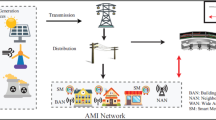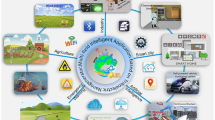Abstract
A system that combines the advantage of the long-range (LoRa) communication method and the structural characteristics of a mesh network for an LoRa mesh network-based wireless electrical load tracking system is proposed. The system demonstrates considerable potential in reducing data loss due to environmental factors in far-field wireless energy monitoring. The proposed system can automatically control the function of each node by confirming the data source and eventually adjust the system structure according to real-time monitoring data without manual intervention. To further improve the sustainability of the system in outdoor environments, a standby equipment is designed to automatically ensure the normal operation of the system when the hardware of the base station fails. Our system is based on the Arduino board, which lowers the production cost and provides a simple manufacturing process. After conducting a long-term monitoring of a near-field smart manufacturing process in South Korea and the far-field energy consumption of rural households in Tanzania, we have proven that the system can be implemented in most regions, neither confined to a specific geographic location nor limited by the development of local infrastructure. This system comprises a smart framework that improves the quality of energy monitoring. Finally, the proposed big-data-technology-based power supply policy offers a new approach for prolonging the power supply time of off-grid power plants, thereby providing a guideline for more rural areas with limited power sources to utilize uninterrupted electricity.












Similar content being viewed by others
Change history
11 February 2021
A Correction to this paper has been published: https://doi.org/10.1007/s40436-020-00332-z
References
John C, Paul P, Jim D et al (2016) International energy outlook 2016 with projections to 2040. USDOE Energy Information Administration (EIA), Washington, DC
Hansen UE, Pedersen MB, Nygaard I (2015) Review of solar PV policies, interventions and diffusion in East Africa. Renew Sustain Energy Rev 46:236–248
Bhandari B, Lee KT, Chu WS et al (2017) Socio-economic impact of renewable energy-based power system in mountainous villages of Nepal. Int J Precis Eng Manuf Green Technol 4(1):37–44
Bhandari B, Ahn SH, Ahn TB (2016) Optimization of hybrid renewable energy power system for remote installations: case studies for mountain and island. Int J Precis Eng Manuf 17:815–822
Park JW, Yi HC, Park MW et al (2016) A monitoring system architecture and calculation of practical recycling rate for end-of-life vehicle recycling in Korea. Int J Precis Eng Manuf Green Technol 1(1):49–57
Chauhan A, Saini RP (2016) Renewable energy based off-grid rural electrification in Uttarakhand state of India: technology options, modelling method, barriers and recommendations. Renew Sustain Energy Rev 51:662–681
Ravi T, Girish K, Chetan S (2014) Remote monitoring for solar photovoltaic systems in rural application using GSM voice channel. Energy Procedia 57:1526–1535
Parikh P, Mitalkumar K, Sidhu TS (2010) Opportunities and challenges of wireless communication technologies for smart grid applications. In: 2010 IEEE PES general meeting, pp 1–7
Kim WH, Lee S, Hwang J (2011) Realtime energy monitoring and controlling system based on Zigbee sensor networks. Procedia Comput Sci 5:794–797
Elkhorchani H, Grayaa K (2016) Novel home energy management system using wireless communication technologies for carbon emission reduction within a smart grid. J Clean Prod 135:950–962
Zou H, Zhou Y, Jiang H et al (2018) A WiFi-based occupancy-driven lighting control system for smart building. Energy Build 158:924–938
Ascensión LV, Manuel F, Marta V (2018) IoT application for real-time monitoring of solar home systems based on Arduino™ with 3G connectivity. IEEE Sens J 19:679–691
Bhandari B, Lee KT, Lee CS et al (2014) A novel off-grid hybrid power system comprised of solar photovoltaic, wind, and hydro energy sources. Appl Energy 133:236–242
Lee JS, Su YW, Shen CC (2007) A comparative study of wireless protocols: Bluetooth, UWB, ZigBee, and Wi-Fi. In: 2007 33rd annual conference of the IEEE industrial electronics society, pp 46–51
IEEE Standard for Information technology—telecommunications and information exchange between systems local and metropolitan area networks— specific requirements - Part 11: wireless LAN medium access control (MAC) and physical layer (PHY) specifications. In: IEEE Std 802.11-2016 (Revision of IEEE Std 802.11-2012), pp 1–3534. https://doi.org/10.1109/IEEESTD.2016.7786995
Hornbuckle CA (2010) Fractional-N synthesized chirp generator. United States Patent US7791415B2, Semtech Corp (May 2007)
Khaled A, Moustafa Y, Mohamed Y (2002) Energyaware TDMA-based MAC for sensor networks. In: System-level power optimization for wireless multimedia communication, pp 21–40
Gaddam SR, Phoha VV, Balagani KS (2007) K-means+ ID3: a novel method for supervised anomaly detection by cascading K-means clustering and ID3 decision tree learning methods. IEEE Trans Knowl Data Eng 19(3):345–354
Amorim RC, Hennig C (2015) Recovering the number of clusters in data sets with noise features using feature rescaling factors. Inf Sci 324:126–145
Acknowledgements
Funding was provided by the National Research Foundation of Korea (NRF) funded by the Ministry of Science, ICT & Future Planning (MSIP) (Grant No. NRF-2017K1A3A9A04013801) and the Applied Basic Research Foundation of Yunnan Province (CN) (Grant No. 2018R1A4A1059976).
Author information
Authors and Affiliations
Corresponding author
Rights and permissions
About this article
Cite this article
Wang, XL., Ha, B., Manongi, F.A. et al. Arduino-based low-cost electrical load tracking system with a long-range mesh network. Adv. Manuf. 9, 47–63 (2021). https://doi.org/10.1007/s40436-020-00310-5
Received:
Revised:
Accepted:
Published:
Issue Date:
DOI: https://doi.org/10.1007/s40436-020-00310-5




